
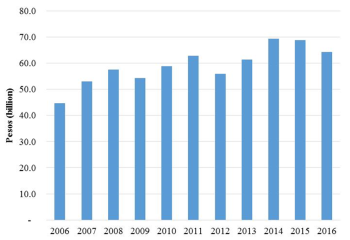
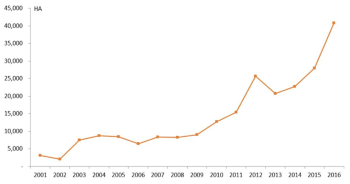
Mexico’s extensive agricultural support program is managed by the Mexican Secretariat of Agriculture, Livestock, Rural Development, Fishery, and Food (Secretaría de Agricultura, Ganadería, Desarrollo Rural, Pesca, y Alimentación [SAGARPA]). According to SAGARPA, Mexican agricultural support amounted to 44.7 billion pesos in 2006, increasing to 64.3 billion pesos in 2016 (Figure 1). Under the current administration, Mexico’s total agricultural support budget for 2013–2016 was 263.7 billion pesos,[1] an average of 65.9 billion pesos per year. These agricultural support programs provide subsidies to individuals and companies to support production, postharvest management, marketing, and other activities to modernize Mexico’s agricultural sector and address rural poverty. A key element of Mexico’s agricultural modernization has been investments in crop production. In 2016, the real net value of Mexican crop production was US$40.6 billion, up 17% from 2011 (World Bank, 2017).
Government support has been particularly instrumental in the development and growth of Mexico’s fruit and vegetable industry. The support has provided producers with much-needed capital, which is usually a major constraint in developing countries. The reduced capital constraint and cost burden have accelerated technology adoption, particularly modern irrigation technologies and protected agriculture, in fruit and vegetable production. For example, the production area of protected agriculture increased from 790 hectares in 2000 to 40,862 hectares in 2016. Protected agriculture is to produce crops under protective structures designed to modify the natural environment. Compared to open field production, protection structures increase yield and quality, contributing to higher added value, improved market access, better competitive position, and rapid penetration in the export market (Guan, Biswas, and Wu, 2017; Wu et al., 2017). Protected facilities mainly produce fruits and vegetables. Figure 2 shows the growth trend of the protected production area in Mexico.
Production subsidies, the focus of this article — along with those supporting business clustering, postharvest management, risk management, marketing, and market development — have provided Mexican agriculture with comprehensive support throughout the entire supply chain. The extensive, strategic agricultural support programs have changed the landscape of the Mexican fruit and vegetable industry and have increased Mexico’s international market shares in major fruit and vegetable crops.
Government support and accelerated technology adoption, coupled with Mexico’s cheaper, ample labor supply, have made Mexico the largest exporter of fruit and vegetable produce to the U.S. market. In 2016, Mexican exports of fruit and vegetables to the United States reached about 10 million tonnes, with a total value of US$12.4 billion, up 57.5% from 2011 (U.S. Department of Agriculture, 2016). To put that in perspective, in the same year, the United States exported US$2.6 billion of corn and US$1.5 billion of soybeans, the two largest agricultural commodities exported to Mexico.
The rapid growth in Mexico’s fruit and vegetable industry is well illustrated with the example of fresh tomatoes. Data from the U.S. Department of Commerce and the USDA show that the supply of Mexican tomatoes in 2000 in the U.S. market (1.3 billion pounds) was 20% less than that of Florida (1.6 billion pounds), the largest fresh tomato producer in the United States. By 2016, the volume of imported Mexican fresh tomatoes was five times higher than Florida’s production (3.6 billion pounds vs. 0.7 billion pounds). The rapidly growing market share of Mexican produce has also been seen in other major crops, such as peppers (Biswas, Guan, and Wu, 2017) and berries (Suh, Guan, and Khachatryan, 2017). The influx of Mexican produce to the U.S. market has placed tremendous pressure on the U.S. fresh produce industry, resulting in U.S. growers calling for more measures against Mexican imports under a renegotiated North American Free Trade Agreement (NAFTA).
This article summarizes Mexican agricultural support during 2013–2016 (under the current administration), with a focus on production subsidies for fruit and vegetable crops. Agricultural support in 2013 was implemented under the 2007–2012 “National Development Plan” structure, while support during 2014–2016 was under the 2013–2018 Plan, which restructured support programs to better promote agricultural development. We first present the support programs and subprograms under these two plans and then detail the specific subprograms that support fruit and vegetable production. We analyze total expenditures on these specific subprograms and the subsidy amounts given to major fruit and vegetable crops. Finally, we provide a more in-depth analysis of subsidies used to support protected agricultural production and highlight the trends for 2001–2016.
SAGARPA implemented agricultural support in 2013 under the 2007–2012 National Development Plan, which aimed to “achieve a competitive economy and generate jobs … and guarantee equal opportunities and environmental sustainability.” It recognized the agricultural sector as a priority for the country’s development, and it defined policies, strategies, and action plans for modernizing agriculture. Five programs were established to improve productivity and efficiency and to better promote agriculture:
The program relevant to crop production activities is the Support Program for Investments in Equipment and Infrastructure. This program aims to promote capital investment in equipment and infrastructure in primary production operations and value-adding processes, particularly through the support of construction and renovation. Five of the program’s eight subprograms provide support for fruit and vegetable production:
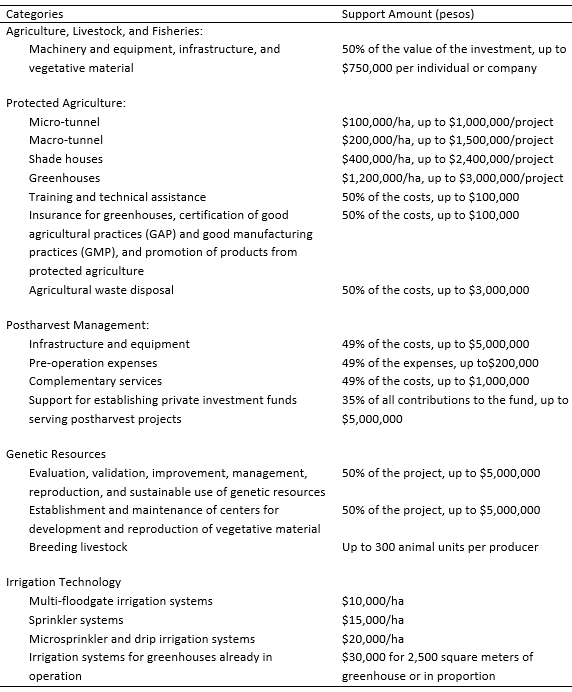

Source: SAGARPA (2013a,b,c,d,e).
Note: Except for the amounts of “Total subprograms,” other “total” amounts only sum up data available
in the table (the actual amount should be higher). “N/A” means not available.
Table 1 lists the support rules of these five subprograms. Table 2 reports the subsidy amounts given to the major fruit and vegetable crops of interest and to the fruit and vegetable industry as a whole. Total expenditures for these five subprograms were 5.2 billion pesos (US$392 million) in 2013.
Table 2 also reports subsidies for the major fruit and vegetable crops under these five subprograms. The breakdown information is not available for the protected agriculture, postharvest management, or irrigation technology subprograms. However, the protected agriculture subsidies were almost exclusively for fruit and vegetable crops, and most, if not all, of the irrigation technology subsidies were directed to fruit and vegetable crops. Assuming that 100% of protected agriculture subsidies, 50% of postharvest management subsidies, and 90% of irrigation technology subsidies were directed to fruit and vegetable crops and adding up all other fruit and vegetable subsidies that were available under the agriculture, livestock, and fisheries (ALF) and the genetic resources subprograms (Table 2) yields a total subsidy for fruit and vegetable production of 2.9 billion pesos (US$222 million) or more (if a higher percentage were used for postharvest management and irrigation technology).
This subprogram supports investment in machinery, equipment, and infrastructure and the acquisition of certified or validated vegetative material for primary agricultural production. The Mexican government will subsidize 50% of the investment value, up to 750,000 pesos (US$56,497) per individual or company. This subprogram spent 1.6 billion pesos in 2013 (US$121 million) (SAGARPA, 2013a).[2] In 2013, support for the fruit and vegetable industry under this subprogram was about 395 million pesos (US$29.7 million), about 25% of total subprogram expenditures.
This subprogram provides support for the infrastructure of protected agriculture and related services, including training and technical assistance. Subsidies are available for micro-tunnels, macro-tunnels, shade houses, and greenhouses (Table 1). For example, to subsidize greenhouse production in 2013, the government provided 1.2 million pesos (US$90,395) per hectare, capping total support at 3 million pesos (US$225,989) per project (Table 1). Total support under this subprogram in 2013 was about 505 million pesos (US$38 million) (Table 2) (SAGARPA, 2013b), of which supports for macro-tunnels, shade houses, and greenhouses accounted for 14 million (US$1 million), 255 million (US$19.2 million), and 230 million pesos (US$17.3 million), respectively, and support for services was about 5 million pesos (US$0.4 million). Protection structures are mainly used to produce fruit and vegetables, including tomatoes, cucumbers, strawberries, and peppers, which together accounted for 90% of the national protected production area in 2013.
The objective of this subprogram is to increase income and employment in the agricultural sector through supporting joint ventures in postharvest projects. The support is available for individuals or companies engaged in agricultural, livestock, or fishery production activities (Table 1). The total investment amount of the projects supported under this subprogram in 2013 was approximately 1.7 billion pesos (US$128 million) (Table 2) (SAGARPA, 2013c). Data for individual crops are unavailable.
This subprogram promotes the evaluation, validation, improvement, management, reproduction, and sustainable use of the country’s agricultural, microbial, livestock, and aquacultural genetic resources, particularly those of biological or economic importance for the production of food, fiber, and fuel (Table 1). Support is directed to individuals or private companies but not to public institutions. The total expenditure under this subprogram was 95 million pesos (US$7 million) in 2013 (Table 2) (SAGARPA, 2013d), about 26% of which, 25 million pesos (US$2 million), was given to the fruit and vegetable industry in 2013.
The objective of this subprogram is to promote the production of food and raw materials by increasing the adoption of irrigation technology at the parcel level (Table 1) on farms. Total support under this subprogram was 1.3 billion pesos (US$98 million) in 2013 (Table 2) (SAGARPA, 2013e), covering 90,562 hectares of production area.
Agricultural support during 2014–2016 was implemented under the 2013–2018 National Development Plan, which recognized “that agriculture is a strategic sector because of its potential to reduce poverty and influence regional development … and that the capitalization of the sector must be strengthened.” The goals of the plan included 1) boosting productivity in the agri-food sector by investing in the development of physical, human, and technological capital and sustainable use of natural resources in the country; 2) creating partnerships that generate economies of scale and greater added value for agri-food producers; 3) promoting greater certainty in agri-food activity through risk management mechanisms; and 4) modernizing the regulatory and institutional framework to create a productive and competitive agri-food sector.
Under the 2013–2018 plan, federal programs were restructured into 11 programs:
In this article, we highlight production subsidies and policies covered by the Program for the Promotion of Agriculture. Its general objective is to increase agricultural productivity through government incentives for integration of production chains (product systems); agro-cluster development; investment in physical, human, and technological capital; production restructuring; postharvest management; and efficient and sustainable use of energy and natural resources. The program contains 14 subprograms: 1) agri-incentives; 2) integral agricultural production; 3) agri-food cluster development; 4) productive PROAGRO; 5) PROCAFE and production incentive for coffee; 6) intensive production and agricultural covers; 7) agricultural commodity systems; 8) irrigation technology; 9) bioenergy and sustainability; 10) production restructuring; 11) incentive program for maize and bean producers; 12) modernization of traditional agriculture; 13) strategic project of subsistence agriculture; and 14) mining. Four of these subprograms, described below, are relevant for fruit and vegetable production.
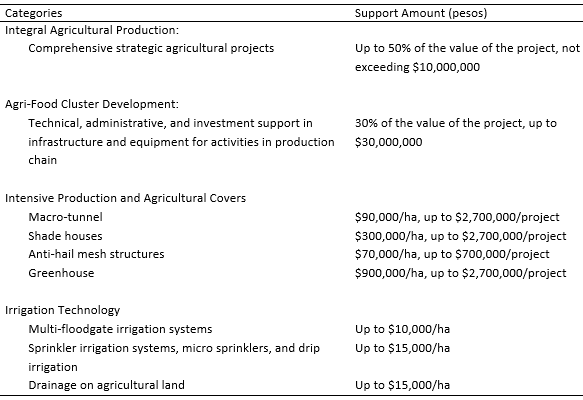
Source: SAGARPA (2014a).
The objective of this subprogram is to provide incentives to companies to increase their competitiveness as well as to provide incentives to agricultural economic units to implement comprehensive strategic agricultural projects. Table 3 lists the support rules.
This subprogram provides incentives to agri-food companies for integration of producers and producer groups to develop and strengthen the value chain, generate economies of scale, increase productivity and competitiveness, promote cooperation, and create greater added value along the value chain to benefit producers.
This subprogram is protected agriculture under a different name. The objective is to subsidize production under protection structures. It has similar per hectare subsidization rules to those under the 2013 program. However, per project subsidy rates for macro-tunnels and shade houses have increased to promote large-scale operations in these types of production. Major crops subsidized under this subprogram were tomatoes, cucumbers, strawberries, and peppers, which accounted for 91.4% of the national protected production area in 2014 (SAGARPA, 2014d).
This subprogram provides incentives to agricultural producers and associations of irrigation users to establish irrigation systems (at the parcel level) on farms to increase production efficiency. The support rules are almost the same as in 2013. The total irrigation area subsidized under this subprogram was 116,607 hectares in 2014 (SAGARPA, 2014e).

Sources: SAGARPA (2015b,c,d,e), SAGARPA (2016a,b,c,d).

Sources: SAGARPA (2014b,c,d,e).
Table 4 reports expenditures of these four subprograms during 2014–2016.[3] Total expenditures of the four subprograms relevant for fruit and vegetable production were 3,106 million pesos (US$227 million); 2,593 million pesos (US$157 million); and 3,520 million pesos (US$181 million) in 2014 to 2016.
Table 5 presents the subsidies for major fruit and vegetable crops received in 2014 under these four subprograms. Assuming 100% of intensive production subsidies and 90% of irrigation technology subsidies were directed to fruit and vegetable crops and adding up all other fruit and vegetable subsidies that are available under the integral agricultural production and the agri-food cluster development subprograms yields a total subsidy of 2.37 billion pesos (US$171 million) for fruits and vegetables.
Again, the discussion of subsides only highlights four subprograms under the program for promotion of agriculture; it does not cover subsidies directed to these crops under other subprograms or other programs, such as the marketing and market development program. This is to highlight major production subsidies given to the fruit and vegetable industry that directly reduce producers’ cost of production, impact technology adoption in primary production operations, and increase the production capacity of the fruit and vegetable industry.
Protected agricultural production is a fast-growing sector in Mexico with heavy support from the government. According to SAGARPA, there were only 790 hectares of protected agriculture in 2000. With an average annual growth of 2,500 hectares per year, however, protected production increased about 52 times to 40,862 hectares in 2016 (SIAP, 2017). Growth took off in 2009 when the Mexican government launched the Strategic Project (National Strategy) for protected agriculture under the Support Program for Investments in Equipment and Infrastructure under the 2007–2012 National Development Plan. In 2015, three types of cover structures—shade houses, plastic tunnels, and greenhouses—accounted for 44%, 10%, and 46%, respectively, of total protected production area. Protection structures are used mainly to produce tomatoes, cucumbers, strawberries, peppers, and eggplants. Tomatoes, cucumbers, strawberries, and peppers under protection structures reached 13,743; 4,046; 2,641; and 3,915 hectares, respectively, in 2015. These four crops accounted for 86% of the total protected area, with tomatoes being the largest (49%) (Figure 3). Recently, berries have received increasing attention as the Mexican government has pushed to double the sector’s production capacity (Fresh Fruit Portal, 2013; Guan et al., 2015). Strawberries made up 9% of total protected area in 2015 but increased to 13% in 2016.
The use of protected production brings many benefits, including higher yield and better quality, improved market access, and rapid penetration in the export market. In 2015, Mexican tomato and strawberry production volumes reached 3.1 and 0.4 million tonnes, respectively, of which approximately 46% and 62%, respectively, were exported, while cucumbers and eggplants exported in the same year accounted for 83% and 37%, respectively, of their total production (SIAP, 2016).
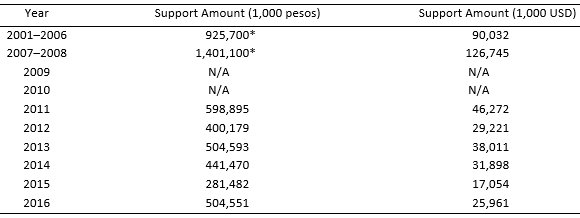
Note: Single asterisks (*) indicate the total amount over the period. Average exchange rates were used.
Considered a strategic sector by the Mexican government, protected production received generous government support to install protection structures and provide relevant services. Table 6 presents the subsidy amounts for 2001–2016. The total amount of subsidies for 2001–2006 was 925.7 million pesos (US$90 million), with subsidization intensifying for 2007–2008, reaching 1.4 billion pesos (US$127 million) (Garcia Victoria et al., 2011). The total subsidy amount for 2011–2016 was 2.73 billion pesos (US$188 million), an average of 455 million pesos (US$31 million) per year. Protected area reached 40,862 hectares in 2016, up 46% from 2015, while the subsidy amount increased by 79% in 2016.
In both developed and developing countries, subsidies could increase farm productivity (e.g., Dorward and Chirwa, 2011; Kazukauskas, Newman, and Sauer, 2014). Subsidies, especially those tied directly to specific industries or activities, can alter farmers’ production and investment behavior and cause the production capacity of subsidized industries to expand. This article examines government support in Mexican agriculture. The Mexican government has an extensive agricultural support program and subsidizes the fruit and vegetable industry throughout the supply chain. This study further provides an in-depth analysis of production subsidies, which directly reduce producers’ production costs and their capital constraints in investment, thus driving technology adoption and industry expansion. In particular, strategic support for the fruit and vegetable industry capitalizes on Mexico’s large and relatively cheap labor supply and is instrumental in the industry’s rapid growth.
However, subsidization is a sensitive, controversial issue. Subsidies could create an uneven playing field in trade and cause losses for producers of its trading partners. For example, in 2015, the U.S. Department of Commerce found that Mexico’s sugar industry had received subsidies; in the same year, the U.S. International Trade Commission (ITC) confirmed that Mexico’s sugar industry had harmed sugar producers in the United States (Lewis and Schmitz, 2015; Schmitz, 2018). The impact of the dramatic growth in Mexico’s fruit and vegetable exports to the United States has also been observed in other crops such as tomatoes (Guan, Biswas, and Wu, 2017; Wu, Guan, and Suh, 2018) and berries (Suh, Guan, and Khachatryan, 2017).
The subsidization practice could have serious political implications, especially at a time of tremendous uncertainty in international trade relations. The total U.S. agricultural trade deficit with Mexico increased to US$6 billion in 2017. Fruit and vegetable imports from Mexico increased to US$13 billion, substantially higher than the combined U.S. exports of corn and soybeans to Mexico (US$4.2 billion). This has resulted in starkly different attitudes among corn and soybean commodity groups and fruit and vegetable groups in the NAFTA renegotiation. The subsidy issue could further split the two major commodity groups in their attitudes and approaches toward NAFTA.
Biswas, T., Z. Guan, and F. Wu. 2017. “An Overview of the US Bell Pepper Industry.” Gainesville, FL: University of Florida, Institute of Food and Agricultural Sciences Publication #FE1028. Available online: http://edis.ifas.ufl.edu/FE1028
Dorward, A., and E. Chirwa. 2011. “The Malawi Agricultural Input Subsidy Programme: 2005/06 to 2008/09.” International Journal of Agricultural Sustainability 9(1):232–247.
Fresh Fruit Portal. 2013. “Mexico Invests in Doubling Strawberry Plantations.” Available online: http://www.freshfruitportal.com/news/2013/08/21/mexico-invests-in-doubling-strawberry-plantations/?country=unitedstates
Garcia Victoria, N., O.M.C. van der Valk, and A. Elings. 2011. “Mexican Protected Horticulture.” The Hague, Netherlands: Dutch Agricultural Economic Research Institute, Rapporten GTB 1126.
Guan, Z., T. Biswas, and F. Wu. 2017. “The US Tomato Industry: An Overview of Production and Trade.” Gainesville, FL: University of Florida, Institute of Food and Agricultural Sciences Publication #FE1027. Available online: http://edis.ifas.ufl.edu/FE1027
Guan, Z., F. Wu, F. Roka, and A. Whidden. 2015. “Agricultural Labor and Immigration Reform.” Choices 30(4):1–9.
Kazukauskas, A., C. Newman, and J. Sauer. 2014. “The Impact of Decoupled Subsidies on Productivity in Agriculture: A Cross-Country Analysis Using Microdata.” Agricultural Economics 45:327–336.
Lewis, K.E., and T.G. Schmitz. 2015. “Measuring the Impact of Mexican Domestic Subsidies on the Trade of Sugar between the U.S. and Mexico.” Journal of Agribusiness 33(1):17–38.
Schmitz, T.G. 2018. “Impact of the 2014 Suspension Agreement on Sugar between the United States and Mexico.” Agricultural Economics 49:55–69.
Secretaría de Agricultura, Ganadería, Desarrollo Rural, Pesca, y Alimentación (SAGARPA). 2010. Diario Oficial, Quinta Sección. Ciudad de México: SAGARPA. Available online: https://www.sep.gob.mx/work/models/sep1/Resource/9721849d-666e-48b7-8433-0eec1247f1ab/a551.pdf
———. 2013a. Ejercicio 2013 – Apoyo a la Inversión en Equipamiento e Infraestructura Agricola. Ciudad de México: SAGARPA. Available online: https://www.sagarpa.gob.mx/sagarpa/datos-2013
———. 2013b. Ejercicio 2013 – Agricultura Protegida. Ciudad de México: SAGARPA. Available online: https://datos.gob.mx/busca/dataset/recursos-otorgados-en-el-ejercicio-2013-de-sagarpa-creado-el-2016-01-27-18-19
———. 2013c. Ejercicio 2013 – Ramas Productivas. Ciudad de México: SAGARPA. Available online: https://datos.gob.mx/busca/dataset/recursos-otorgados-en-el-ejercicio-2013-de-sagarpa-creado-el-2016-01-27-18-19
———. 2013d. Ejercicio 2013 – Recursos Genéticos. Ciudad de México: SAGARPA. Available online: https://datos.gob.mx/busca/dataset/recursos-otorgados-en-el-ejercicio-2013-de-sagarpa-creado-el-2016-01-27-18-19
———. 2013e. Ejercicio 2013 – Tecnificación del Riego. Ciudad de México: SAGARPA. Available online: https://datos.gob.mx/busca/dataset/recursos-otorgados-en-el-ejercicio-2013-de-sagarpa-creado-el-2016-01-27-18-19
———. 2014a. Diario Oficial, Poder Ejecutivo. Ciudad de México: SAGARPA. Available online: dof.gob.mx/nota_to_pdf.php?fecha=11/08/2014&edicion=VES
———. 2014b. Ejercicio 2014 – Agroproducción Integral. Ciudad de México: SAGARPA. Available online: https://datos.gob.mx/busca/dataset/recursos-otorgados-en-el-ejercicio-2014-de-sagarpa-creado-el-2016-01-27-18-19/resource/3ef2edcb-0766-4e11-80ad-ddb0e0624c5a?inner_span=True
———. 2014c. Ejercicio 2014 – Agrocluster. Ciudad de México: SAGARPA. Available online: https://datos.gob.mx/busca/dataset/recursos-otorgados-en-el-ejercicio-2014-de-sagarpa-creado-el-2016-01-27-18-19/resource/fd52787a-d362-4994-9bfd-97c629b62475?inner_span=True
———. 2014d. Ejercicio 2014 – Producción Intensiva y Cubiertas Agricolas (PROCURA). Ciudad de México: SAGARPA. Available online: https://datos.gob.mx/busca/dataset/recursos-otorgados-en-el-ejercicio-2014-de-sagarpa-creado-el-2016-01-27-18-19/resource/fe6e7fc7-ffb8-434f-bf1b-3242ef2bb4ba?inner_span=True
———. 2014e. Ejercicio 2014 – Tecnificación del Riego. Ciudad de México: SAGARPA. Available online: https://datos.gob.mx/busca/dataset/recursos-otorgados-en-el-ejercicio-2014-de-sagarpa-creado-el-2016-01-27-18-19/resource/17925f50-8787-41f9-9065-d1c01f1c5df1?inner_span=True
———. 2015a. Diario Oficial, Poder Ejecutivo, Programa de Fomento a la Agricultura 2015/Compnente de Producción Intensive y Cubiertas Agricolas (PROCURA). Ciudad de México: SAGARPA. Available online: https://www.gob.mx/cms/uploads/attachment/file/90897/DOF-20151230_ROP_2016_Fomento_Productiv.pdf
———. 2015b. Ejercicio 2015 – Agroproducción Integral. Ciudad de México: SAGARPA. Available online: http://portaltransparencia.gob.mx/pot/programaSubsidio/consultarProgramaSubsidio.do?method=edit&idSubsidios=SA2015C02&_idDependencia=00008
———. 2015c. Ejercicio 2015 – Agrocluster. Ciudad de México: SAGARPA. Available online: http://portaltransparencia.gob.mx/pot/programaSubsidio/consultarProgramaSubsidio.do?method=edit&idSubsidios=SA2015C04&_idDependencia=00008
———. 2015d. Ejercicio 2015 – Producción Intensiva y Cubiertas Agricolas (PROCURA). Ciudad de México: SAGARPA. Available online: http://portaltransparencia.gob.mx/pot/programaSubsidio/consultarProgramaSubsidio.do?method=edit&idSubsidios=SA2015C01&_idDependencia=00008
———. 2015e. Ejercicio 2015 – Tecnificación del Riego. Ciudad de México: SAGARPA. Available online: http://portaltransparencia.gob.mx/pot/programaSubsidio/consultarProgramaSubsidio.do?method=edit&idSubsidios=SA2015C05&_idDependencia=00008
———. 2016a. Preliminares Ejercicio 2016 – Agroproducción Integral. Ciudad de México: SAGARPA. Available online: http://portaltransparencia.gob.mx/pot/programaSubsidio/consultarProgramaSubsidio.do?method=edit&idSubsidios=SA2016C02&_idDependencia=00008
———. 2016b. Preliminares Ejercicio 2016 – Agrocluster. Ciudad de México: SAGARPA. Available online: http://portaltransparencia.gob.mx/pot/programaSubsidio/consultarProgramaSubsidio.do?method=edit&idSubsidios=SA2016C10&_idDependencia=00008
———. 2016c. Preliminares Ejercicio 2016 – Producción Intensiva y Cubiertas Agricolas (PROCURA). Ciudad de México: SAGARPA. Available online: http://portaltransparencia.gob.mx/pot/servicio/consultarServicio.do?method=edit&idServicio=SAGARPA-16-002-D&_idDependencia=00008
———. 2016d. Preliminares Ejercicio 2016 – Tecnificación del Riego. Ciudad de México: SAGARPA. Available online: http://portaltransparencia.gob.mx/pot/programaSubsidio/consultarProgramaSubsidio.do?method=edit&idSubsidios=SA2016C01&_idDependencia=00008
Servicio de Información Agroalimentaria y Pesquera (SIAP). 2016. 2016 Food and Agricultural Atlas. Ciudad de México: SIAP. Available online: http://nube.siap.gob.mx/gobmx_publicaciones_siap/pag/2016/Agricultural-Atlas-2016
———. 2017. Anuario Estadístico de la Producción Agrícola. Ciudad de México: SIAP. Available online: http://infosiap.siap.gob.mx/aagricola_siap_gb/ientidad/index.jsp
Suh, D.H., Z. Guan, and H. Khachatryan. 2017. “The Impact of Mexican Competition on the US Strawberry Industry.” International Food and Agribusiness Management Review 20(4):591–604.
U.S. Department of Agriculture. 2016. Global Agricultural Information Network. Washington, DC: U.S. Department of Agriculture, Foreign Agricultural Service. Available online: https://gain.fas.usda.gov/Pages/Default.aspx
World Bank. 2017. World Development Indicators: Agriculture, Forestry, and Fishing, Value Added (Constant 2010 US$). Washington, D.C.: World Bank. Available online: https://data.worldbank.org/indicator/NV.AGR.TOTL.KD?end=2016&locations=MX&start=1965&view=chart
Wu, F., Z. Guan, J.J. Arana-Coronado, and M. Garcia-Nazariega. 2017. “An Overview of Strawberry Production in Mexico.” Gainesville, FL: University of Florida, Institute of Food and Agricultural Sciences Publication #FE1014. Available online: http://edis.ifas.ufl.edu/FE1014
Wu, F., Z. Guan, and D.H. Suh. 2018. “The Effects of Tomato Suspension Agreements on Market Price Dynamics and Farm Revenue.” Applied Economic Perspectives and Policy 40(2):316–332.
[1] Total support budget for years 2013–2016 was the sum of the annual mid-year revised budgets.
[2] We used the 2013 average exchange rate of 13.275 pesos per U.S. dollar.
[3] We used annual average exchange rates in this conversion: 13.84, 16.50, and 19.435 in 2014, 2015, and 2016, respectively.